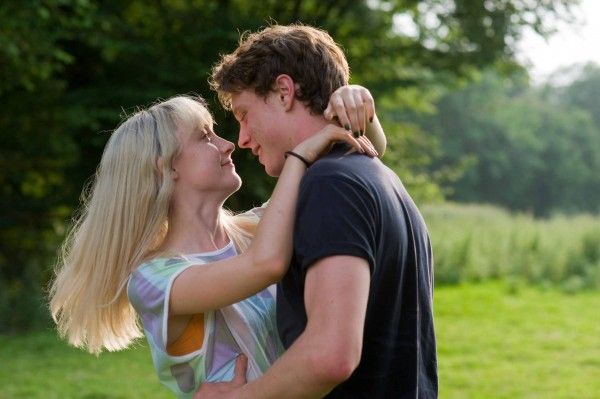In Kevin Macdonald’s How I Live Now, perspective on life is supposed to be shown between two extremes. Life is either ideal or a waking nightmare, and through this comparison we can learn to put our priorities and values in order. But painting the world in white and black makes the movie uninteresting from both sides. Furthermore, the good times and end times are about as complex as home realty: location, location, location. There’s no room for the grey area, which is where most of us live in the real world.
Daisy (Saoirse Ronan) is a sullen teenager who has been sent by her father to go live in the English countryside with her step-cousins. Being a sullen teen, Daisy has no patience for her younger step-cousins Isaac (Tom Holland) and Piper (Harley Bird). However, Daisy does have eyes for her hunky step-cousin Edmund (George MacKay), and eventually warms to the other family members. When her Aunt Penn (Anna Chancellor), who is monitoring an escalating global conflict, flies to Geneva for a conference, the kids are left to look after themselves. They laugh and play in fields, swim in the creek, and have a grand old time. The only problem is that World War III is brewing just over the horizon, and without parental supervision, the kids aren’t sure how to deal with the fallout just outside their door.
How I Live Now reaffirms my belief that with all things being equal, if I’m given the choice between a nice movie and a harsh movie, I will choose the former. Both halves of How I Live Now are one-dimensional and overbearing, but at least it’s nice seeing these kids be happy. It gives us hope and hints that the war they’re seeing from afar won’t come to their doorstep. They’re innocents, and perhaps away from civilization, they can live out their lives. But innocence isn’t built to last, and Macdonald shifts his movie to atrocity after atrocity in the second half.
There’s nothing in the movie that helps bridge the shift. It’s an intentionally shocking transition, but the other side is just as monotonous. Daisy’s arc is supposed to tie the two halves together, but she’s somewhat shallow either way, and as film critic Jordan Hoffman pointed out on Twitter, Ronan’s one note has played itself out. I would like to point out that she does have at least some range (as seen in Violet & Daisy), but I agree that her lone-wolf-looking-for-a-home character has grown tired even though she plays it very well. However, the thinness of that character is prominently displayed in How I Live Now because she’s stuck in flat surroundings. The world is either wonderful or horrible, and that simplification reduces the presence of everything, including the performances.
Macdonald has the skill to leave an impact on both sides, but at the same time, it’s not too difficult to do so when you’re working at the extremes. Most people don’t live in perfect harmony; I would be willing to wager that far more live in hellish landscapes. Presumably, most viewers who see How I Live Now live in neither, and Macdonald is aware of this. Like Daisy, we’re supposed to see how good things can be, and how bad they can get as if the world was designed for personal epiphanies. How I Live Now takes Daisy through heaven and hell, and it’s a tiring slog to reach such an unsatisfying, obvious destination.
Rating: D
For all of our TIFF 2013 coverage, click here. Here are links to all of my TIFF 2013 reviews:
- 12 Years a Slave
- August: Osage County
- Bethlehem
- Blood Ties
- Blue Is the Warmest Color
- Can a Song Save Your Life?
- Dallas Buyers Club
- Devil’s Knot
- Dom Hemingway
- The Double
- Enough Said
- The F Word
- Fat
- The Fifth Estate
- Gravity
- Jodorowsky’s Dune
- Labor Day
- Man of Tai Chi
- The Missing Picture
- Parkland
- Prisoners
- The Wind Rises



